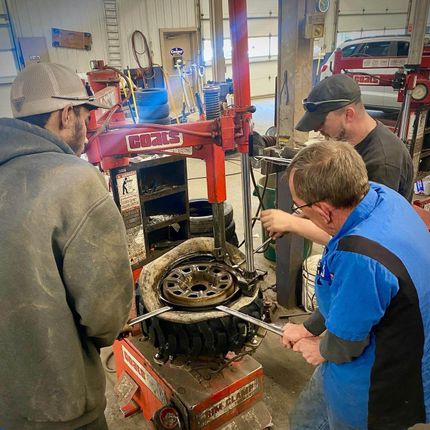Tire Service: The Impact of Weather Conditions
When it comes to ensuring optimum efficiency and safety and security when driving, understanding the effect of weather on tire service is essential. From scorching heat to icy roadways, each climate aspect can substantially affect tire functionality and total driving experience. By delving right into the effects of varying weather on tires, vehicle drivers can gain valuable insights that might enhance their lorry's performance and longevity. In this conversation, we will discover the intricate connection in between weather and tire solution, losing light on the relevance of weather-specific tire upkeep methods and considerations.
Warm and Tire Performance
When revealed to high temperature levels, tires experience adjustments in efficiency that can considerably influence car safety and handling. The warmth created from extended driving or warm climate conditions triggers the tire rubber to soften, leading to reduced step life and enhanced wear.

Cold Weather Condition Effects
Winter conditions can have a considerable influence on tire performance and safety. As temperatures decline, tire rubber can harden, resulting in decreased grip on icy or snow-covered roads. In winter, tires might additionally shed atmospheric pressure a lot more swiftly, which can impact dealing with and gas effectiveness. Additionally, cool temperatures can cause tire sidewalls to stiffen, raising the danger of damage from pits or various other roadway hazards.
To reduce the results of cold weather on tires, it is critical to frequently check tire pressure and inflate them to the producer's suggested levels. Making use of winter or all-season tires made for winter conditions can additionally boost grip and grip on icy or snowy roadways. Appropriate tire upkeep, consisting of regular examinations for wear and damages, comes to be also more important throughout chillier months to make sure ideal efficiency and safety.
Rainy Conditions Effect
Tires with damaged footsteps are much more susceptible to hydroplaning, where a layer of water constructs up in between the road and the tire surface, leading to loss of grip. To battle this, vehicle drivers need to frequently inspect their tires for sufficient walk deepness and consider investing in tires especially made for damp problems.
Moreover, stormy weather condition can additionally reduce presence, making it testing for chauffeurs to see the roadway in advance clearly (GMC Tire Service). In such problems, it is necessary to readjust driving rates appropriately and maintain a safe adhering to range to enable unexpected quits. Effectively filled why not find out more with air tires can additionally assist in preserving control on damp roads by offering better handling and grasp
Snow and Tire Safety And Security
Snow-covered roadways position unique obstacles for motorists, highlighting the significance of proper tire choice and maintenance. When driving in snowy conditions, having the appropriate tires can make a significant distinction in safety and performance. Winter tires are designed with special rubber substances and walk patterns to supply far better traction on snow and ice contrasted to all-season tires. The much deeper footsteps and sipes of winter season tires aid grasp the road better, decreasing the threat of slipping and moving.

Moreover, vehicle drivers ought to think about setting up tire chains in severe snowy problems. Tire chains give additional traction by grasping the snow and ice, enhancing security and control. It is important to comply with producer guidelines when installing and using tire chains to prevent damage to the tires and automobile (GMC Tire Service). By choosing the right tires, maintaining appropriate rising cost of living, and considering added traction aids like tire chains, motorists can boost their security when browsing snow-covered roads.
Weather-Related Tire Maintenance
When confronted with various climate conditions, appropriate tire maintenance ends up being an important facet of car safety and performance. Weather-related tire upkeep includes a variety of practices intended at making certain optimal tire function and long life in various weather circumstances. One vital aspect of weather-related tire upkeep is tire pressure law. Varying temperature levels can trigger tire pressure to differ, influencing traction and gas efficiency. Frequently examining and adjusting tire stress according to manufacturer referrals is essential for risk-free driving in transforming climate condition. Additionally, tire walk depth plays a considerable role in managing website link various climate elements. Tires with appropriate tread depth supply far better grasp on damp or icy roadways, lowering the risk of hydroplaning or skidding. When walk wear reaches a certain deepness is important for preserving grip and security in negative weather, evaluating tire step on a regular basis and changing tires. By prioritizing weather-related tire upkeep, chauffeurs can improve security, boost car performance, and prolong get redirected here the lifespan of their tires.
Conclusion
Finally, climate condition have a significant influence on tire performance and security. From warm affecting tire pressure and wear to cool climate decreasing grip, it is necessary to think about the weather condition when keeping and utilizing tires. Wet problems can lower grip and result in hydroplaning, while snow can raise the risk of accidents if tires are not correctly furnished. Weather-related tire maintenance is vital in guaranteeing ideal performance and safety and security on the roads.
In this discussion, we will explore the complex partnership in between climate conditions and tire service, losing light on the significance of weather-specific tire upkeep practices and considerations.
